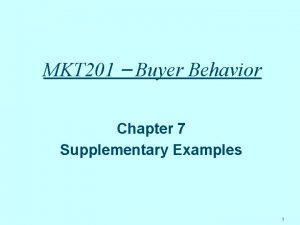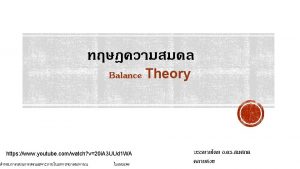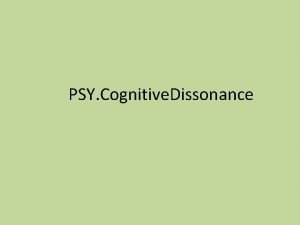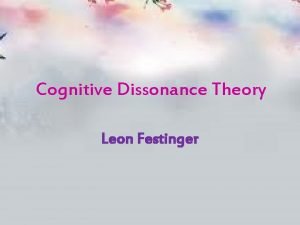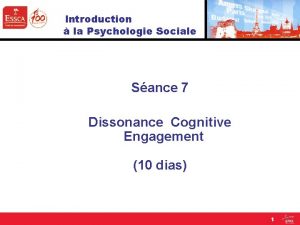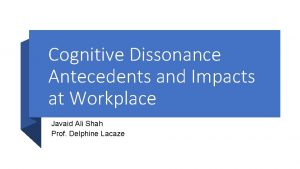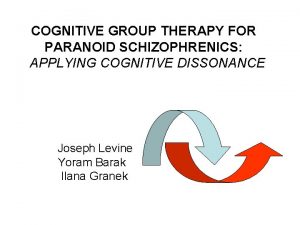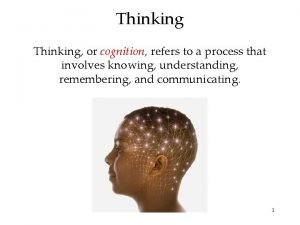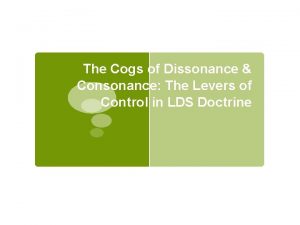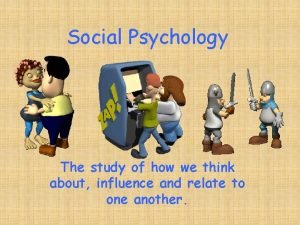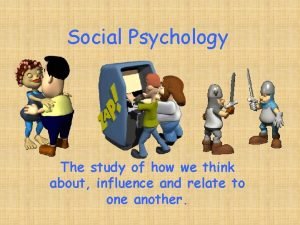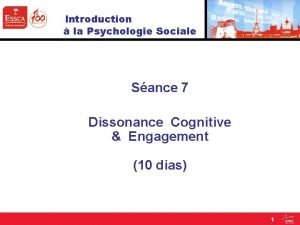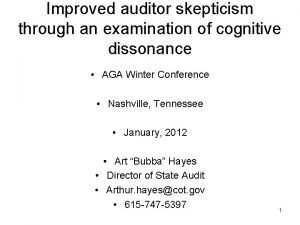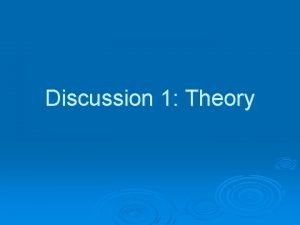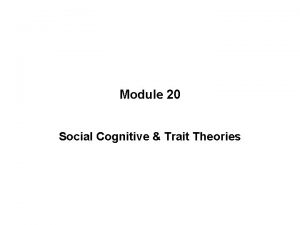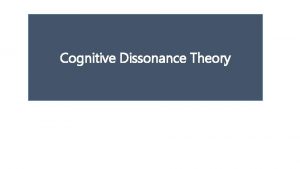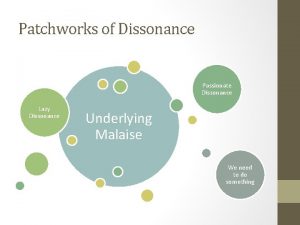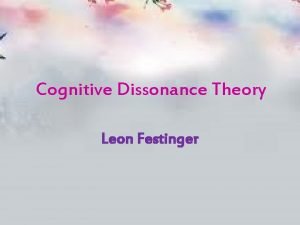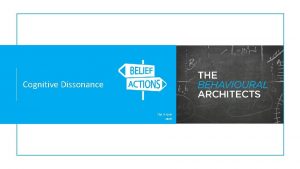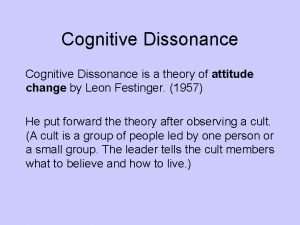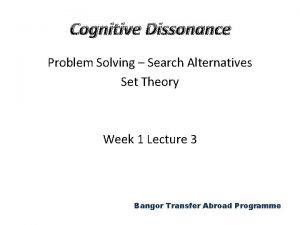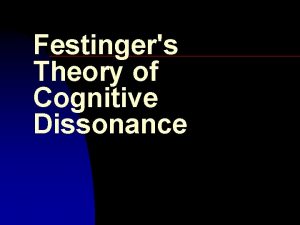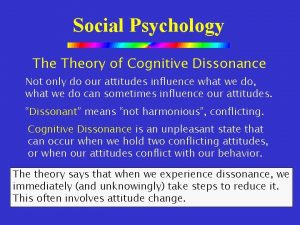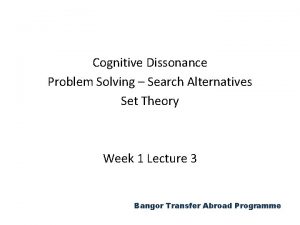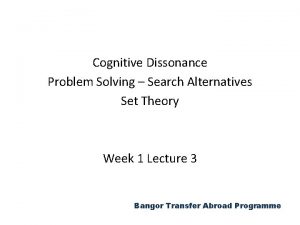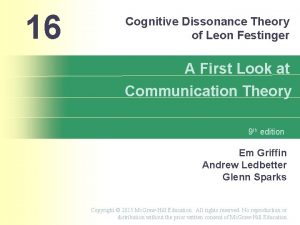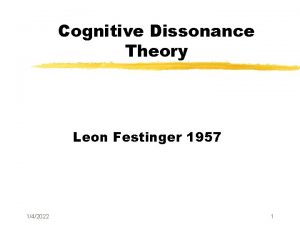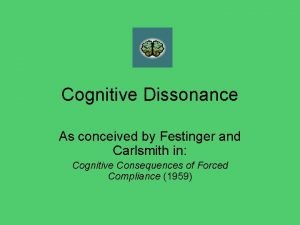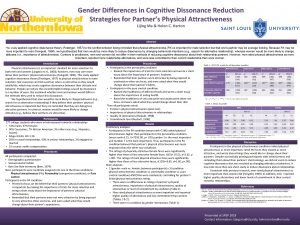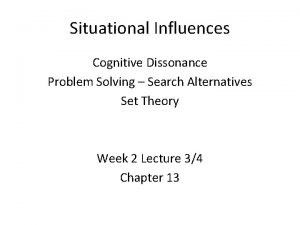Ch 6 Cognitive Dissonance Theory Announcements Paper 1




















- Slides: 20

Ch. 6: Cognitive Dissonance Theory

Announcements Paper 1 due in 4 weeks n Quiz 3 posted today at 5 pm n

Review from Last Class n Reducing Cognitive Dissonance ¨ Denial (easier/less effective) ¨ Bolstering (easier/less effective) ¨ Transcendence (harder/more effective) ¨ Differentiation (harder/more effective)

In Today’s Class Cognitive Dissonance Contexts n Conditions for Cognitive Dissonance n Applying Cognitive Dissonance Theory n Critiquing Cognitive Dissonance Theory n

Cognitive Dissonance Contexts

Contexts of Cognitive Dissonance Induced Compliance n Hypocrisy n Decision-making n Effort justification n

Contexts of Cognitive Dissonance: Induced Compliance n Festinger & Carlsmith (1959) study ¨ Pay participants either $1 or $20 to perform a very dull task ¨ Then ask them to lie to the next participant, saying that the task was fun ¨ Then measure participants’ attitudes toward the activity n Festinger & Carlsmith’s finding: ¨ People who were paid $1 had more positive attitudes toward the activity than those paid $20

Contexts of Cognitive Dissonance: Induced Compliance Festinger & Carlsmith’s (1959) study shows us: n The smaller the incentive for behavior, the greater cognitive dissonance experienced n The greater cognitive dissonance experienced, the greater attitude change experienced n Participants bolstered their thoughts, adding positive cognitions to reduce the ratio of dissonant to consonant cognitions

Contexts of Cognitive Dissonance: Hypocrisy n Hypocrisy ¨ Saying one thing and doing another ¨ Reminding the participant of their current attitude toward an issue and showing that their behavior is not consistent with that attitude n Pro-attitudinal behavior ¨ Behavior attitudes that is consistent with a person’s

Contexts of Cognitive Dissonance: Hypocrisy How to use hypocrisy for persuasion 1. Make current attitude salient 2. Recommend prosocial behaviors 3. Make past failures salient 4. Use recent past failures 5. Create private awareness (not public)

Contexts of Cognitive Dissonance: Decision-Making Steps of Decision-Making 1. Conflict 2. Decision 3. Cognitive Dissonance 4. Dissonance Reduction 1. We tend to perceive our choice as better after the fact than at the time of the decision

Contexts of Decision-Making: Effort Justification n Effort justification ¨ Providing a reason for performing very unpleasant behaviors in order to achieve a desired goal n Examples ¨ Hazing or initiation into groups like athletic clubs, Greek organizations, or certain professions n Implications for persuasion ¨ (Up to a point) the more unpleasant behaviors a person has to go through to join a group, the more loyalty & positive affect they will feel toward the group

Necessary Conditions for Cognitive Dissonance

Conditions for Cognitive Dissonance n Aversive consequences ¨ Possible n outcomes that the receiver wants to avoid Freedom of choice ¨ The situation must not be forced, but present options freely n Insufficient external justification for behavior ¨A person must look internally (within themselves) to find an explanation for their behavior

Applying Cognitive Dissonance Theory

Applying Cognitive Dissonance: Group Work n n Goal: Use cognitive dissonance to persuade a person to start exercising Answer these questions: ¨ How would you go about creating dissonance in the non-exercising person? ¨ How would you expect the person to react to your tactics? How do you want them to feel? ¨ How might the person react to your tactics, other than changing their behavior?

Critiquing Cognitive Dissonance Theory

Critique of Cognitive Dissonance Theory n Strengths ¨ Theoretical explanation ¨ Prediction & control in applied n settings Limitations ¨ Difficult to disprove because of breadth ¨ Breadth also decreases prediction & control ¨ Hard to use when trying to reinforce currently held attitudes ¨ Findings that support this theory can also support another theory: Self-perception theory

Looking Ahead n Monday 10. 4: Self-Perception Theory ¨ Read: n Wednesday 10. 6: Self-Perception Theory ¨ Read: n p. 135 -155 Burger & Caldwell (2003) Friday 10. 8: Self-Perception Theory ¨ QUIZ 4 POSTED on ANGEL

Thanks for your attention! Have a great day!
 Cognitive dissonance theory example
Cognitive dissonance theory example Cognitive dissonance theory
Cognitive dissonance theory How to reduce cognitive dissonance
How to reduce cognitive dissonance Contoh cognitive dissonance
Contoh cognitive dissonance La dissonance cognitive définition
La dissonance cognitive définition How to reduce cognitive dissonance in the workplace
How to reduce cognitive dissonance in the workplace Cognitive dissonance
Cognitive dissonance Cognitive dissonance definition
Cognitive dissonance definition Cognitive dissonance
Cognitive dissonance Central route of persuasion
Central route of persuasion Cognitive dissonance ap psych
Cognitive dissonance ap psych Dissonance cognitive
Dissonance cognitive Cognitive dissonance
Cognitive dissonance Cognitive dissonance example
Cognitive dissonance example Cognitive and non cognitive religious language
Cognitive and non cognitive religious language Trait theory vs social cognitive theory
Trait theory vs social cognitive theory Pvu official announcement
Pvu official announcement R/announcements
R/announcements David ritthaler
David ritthaler What did mildred regret losing in the fire
What did mildred regret losing in the fire Potentiial
Potentiial
